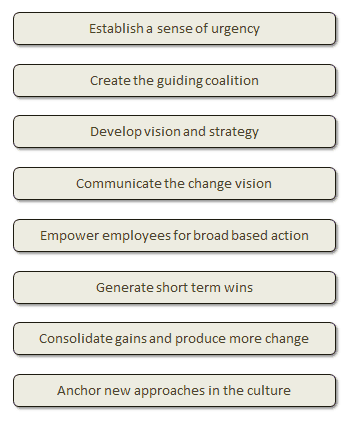Can you guess the most popular question I get in an ITIL class?
Can you guess the most popular question I get in an ITIL class?
Can you guess the most popular question I get in an ITIL class?
- "What process should we start with?" – No.
- "How do I become an ITIL expert?" – No.
- "What is the best approach to implementing Change Management?" – No.
- "How do I get executive level support for our Service Management initiative?" – Yes!
Let me set the scenario up. It's commonly known (at least should be by now) that any major initiative must have executive level support in order to succeed. It has been my experience, both in the classroom as well as on client sites that executives generally do support Service Management and are keenly aware of (or even acknowledge ownership of) implementation efforts. The issue I see is that there is typically a major gap in communications between the executive and practitioner levels. It's not uncommon to witness the following scenario.
Executive: "I fully endorse this initiative. This organization depends on a solid Service Management platform and has even invested time and money into training, tools, and assistance. Why are we not making any significant progress?" Practitioner (from the same company): "We've been sending our staff to training and working very hard on this huge project. There are a lot of key decisions that need to be made very soon, and it seems that we are having a very difficult time getting the executive level of support we need to keep the momentum." |
Do you see the same gap I see?
I understand that this is not always the story, but you might be surprised at how often this same scenario plays out. Of course, there are situations where the needed support is clearly missing from either the executive or practitioner levels, but in any case, I still need to share with you my thoughts and experiences regarding how to address this issue.
Enter Change Enablement.
Notice I didn't say Chang Management which should trigger thoughts of change control, CABs, RFCs, and change schedules. I said Change Enablement. What's the difference? It’s very hard in today’s complex environments to find a definition that best suits the specific needs of each organization, but here are some common definitions to consider:
Change. Replace or modify something in position, course, direction, or attribute.
Change Management (aka Change Control). From a technical perspective, this is the process of defining, assessing, scheduling and coordinating a technically related change.
Change Enablement, (aka Organizational Change). From a cultural or organization perspective, this is the application of knowledge and tools to deal with changes that instill new values, attitudes and behaviors within the organization experiencing the change.
Now, having these basic terms defined, let’s take a closer look at the third definition – change enablement. If you haven't picked up on my hypothesis yet, here it is: Your implementation effort, whether Service Management or any other framework or process is doomed to fail without proper change enablement. Processes, activities, organizational designs can all be intricately designed with clear policies and procedures, but without support from the organization during the deployment phase all efforts are mute. This leads back to my original observation that most companies DO have support at most levels, but have inadequately applied leadership (at all levels) principles to change enablement.
In a nutshell, I believe that change enablement includes some common core principles that should be considered in all change efforts: 1) communication, 2) communication, and 3) communication. Whether written, verbal, or non-verbal, communication channels must always be considered and planned, with the overarching goal of ensuring that what is being communicated supports the efforts and actions being taken, say what you are going to do, and do what you said you were going to do. Done properly, this can help immensely with understanding, and ultimately buy-in at all levels.
In my opinion, one of the best resources in the market today that can help you tackle the complex tasks in organizational change is the time honored book, Leading Change by John P. Kotter. To date, I’ve read this book three times and have learned something new each time. I won’t offer any detailed analysis of the book here, but I think it’s important to illustrate that there are eight key stages to change:
Of course, this is a model you can use for overall improvement efforts at any organization, but what about the specific answers to the number one question I mentioned above? Below are what I consider my top ten practices that I believe can help you fill the gap between expectations. On all change efforts I’ve been involved in, I always try my best to incorporate Kotter’s advice with the following key tenets:
From the executive viewpoint
- Make sure your improvement vision and strategy are real, and ensure that your team hears it from YOU.
- Set expectations that stretch the team’s capabilities; once they are achieved the bar will be that much higher.
- Be sure the actions you demonstrate are consistent with the change vision and expectations you have set.
- Read, understand, and take actions on the metrics and key performance indicators that are used to guide the improvement efforts.
- If training is conducted as a part of the effort, train with the rest of the organization – don’t have a separate executive session.
From the practitioner viewpoint
- Identify improvement opportunities and communicate them up with some type of ‘business case’ that shows how and why it’s important.
- When your efforts begin to demonstrate wins, the overall effort becomes viral so keep moving forward.
- Don’t feel put out if your suggestions are not immediately recognized by upper management. There may be other more important suggestions from others, but don’t be afraid to ask why.
- Try to put improvement goals and achievements on your performance reviews, and ask your leadership how their performance goals are supporting yours.
- Don’t be afraid to ask upper management their thoughts and inputs on change efforts, you might be surprised to find they either know about it, or are willing to take ownership of it!
I understand that these ideas will not help you with every scenario, but are great places to start.
As always, I’m interested in your thoughts, ideas and techniques. Please feel free to offer any additional suggestions.
Mark Thomas – Director of Business Services
Interface Technical Training
You May Also Like
A Simple Introduction to Cisco CML2
0 3896 0Mark Jacob, Cisco Instructor, presents an introduction to Cisco Modeling Labs 2.0 or CML2.0, an upgrade to Cisco’s VIRL Personal Edition. Mark demonstrates Terminal Emulator access to console, as well as console access from within the CML2.0 product. Hello, I’m Mark Jacob, a Cisco Instructor and Network Instructor at Interface Technical Training. I’ve been using … Continue reading A Simple Introduction to Cisco CML2
Creating Dynamic DNS in Network Environments
0 642 1This content is from our CompTIA Network + Video Certification Training Course. Start training today! In this video, CompTIA Network + instructor Rick Trader teaches how to create Dynamic DNS zones in Network Environments. Video Transcription: Now that we’ve installed DNS, we’ve created our DNS zones, the next step is now, how do we produce those … Continue reading Creating Dynamic DNS in Network Environments
Cable Testers and How to Use them in Network Environments
0 727 1This content is from our CompTIA Network + Video Certification Training Course. Start training today! In this video, CompTIA Network + instructor Rick Trader demonstrates how to use cable testers in network environments. Let’s look at some tools that we can use to test our different cables in our environment. Cable Testers Properly Wired Connectivity … Continue reading Cable Testers and How to Use them in Network Environments





